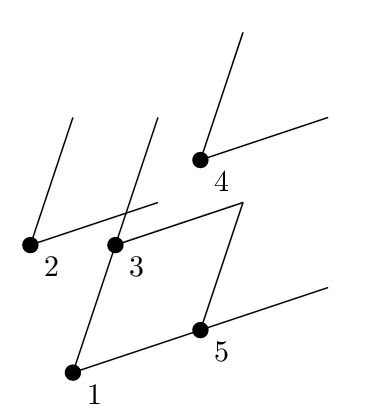
Zadanie Lampy słoneczne (lam)
Pomóż nam usprawnić bazę zadań!
Number of users: 59
Number of users with 100 points: 19
Average result: 57.3729
Solar lamps
Memory limit: 128 MB
Byteasar has a large and pretty garden. As he would like to be able to appreciate its beauty even after dusk, he installed lamps across the garden.
The lamps are directional, i.e., they illuminate only a certain angle, common to them all. Moreover, Byteasar has aligned them so that they all face the same direction. Last but not least, these are solar lamps, i.e., they come with solar panels but no batteries, strangely enough! You might think the panels are thus useless, and each lamp will require electricity at night, but not quite: A lamp will produce light if a sufficient number of lamps illuminate it.
By now, Byteasar has even come up with an order he is going supply the lamps with electricity,
thus turning them on.
For simplicity, we number the lamps from 1 to  in this order, i.e., the lamp no.
in this order, i.e., the lamp no.  is supplied with electricity at time
is supplied with electricity at time  . The only thing left for Byteasar (and you, of course!) is to
figure out when exactly each lamp will start emitting light. Help Byteasar by writing a program
that will determine the answer to this question.
. The only thing left for Byteasar (and you, of course!) is to
figure out when exactly each lamp will start emitting light. Help Byteasar by writing a program
that will determine the answer to this question.
Input
The first line of the standard input contains a single integer  (
( ): the number of lamps Byteasar installed.
In the second line of input, there are four integers
): the number of lamps Byteasar installed.
In the second line of input, there are four integers  (
( ,
,  ), separated by single spaces,
that describe the area illuminated by every lamp.
Namely, if there is a lamp located at the point
), separated by single spaces,
that describe the area illuminated by every lamp.
Namely, if there is a lamp located at the point  , then it illuminates
the area (together with its edge) within the smaller of the two angles formed by two
rays that both originate at
, then it illuminates
the area (together with its edge) within the smaller of the two angles formed by two
rays that both originate at  such that the
such that the  -th (for
-th (for  ) ray passes through
) ray passes through
 . This angle is always smaller than
. This angle is always smaller than  degrees.
degrees.
The  input lines that follow specify the locations of the lamps:
the
input lines that follow specify the locations of the lamps:
the  -th such line contains two integers
-th such line contains two integers  ,
(
,
( ) separated by a single space,
that indicate that the lamp no.
) separated by a single space,
that indicate that the lamp no.  is located at the point
is located at the point  .
You may assume that no two lamps share their location.
.
You may assume that no two lamps share their location.
The last line of the input contains  integers
integers  (
( ),
separated by single spaces, that signify that if the lamp no.
),
separated by single spaces, that signify that if the lamp no.  is in the area illuminated by
at least
is in the area illuminated by
at least  other lamps, then it will start emitting light as well.
other lamps, then it will start emitting light as well.
In tests worth  of the total score, it holds that
of the total score, it holds that  .
.
Output
Your program should print out to the standard output a single line with  integers
integers
 , separated by single spaces.
The number
, separated by single spaces.
The number  should be the time when the lamp no.
should be the time when the lamp no.  starts producing light.
starts producing light.
Example
For the input data:
5 3 1 1 3 2 1 1 4 3 4 5 6 5 2 1 2 1 3 2
the correct result is:
1 2 1 2 5

Explanation: At time 1 Byteasar powers on the lamp 1, which also causes the lamp 3 to produce light. Once the lamp 2 is powered on, the lamp 4 begins to emit light (being illuminated by lamps 1, 2, and 3).
Sample grading tests:
- 1ocen:
 , a small random test;
, a small random test;
- 2ocen:
 , the lamps illuminate a zero angle (Byteasar bought lasers by mistake);
, the lamps illuminate a zero angle (Byteasar bought lasers by mistake);
- 3ocen:
 , the lamps form a
, the lamps form a  grid and illuminate a
grid and illuminate a  degree angle with its sides parallel to the Cartesian coordinate system axes.
degree angle with its sides parallel to the Cartesian coordinate system axes.
Task author: Wojciech Nadara.
<Submit a solution> [0/100]Kontakt
In the event of technical difficulties with Szkopuł, please contact us via email at [email protected].
If you would like to talk about tasks, solutions or technical problems, please visit our Discord servers. They are moderated by the community, but members of the support team are also active there.

 English
English